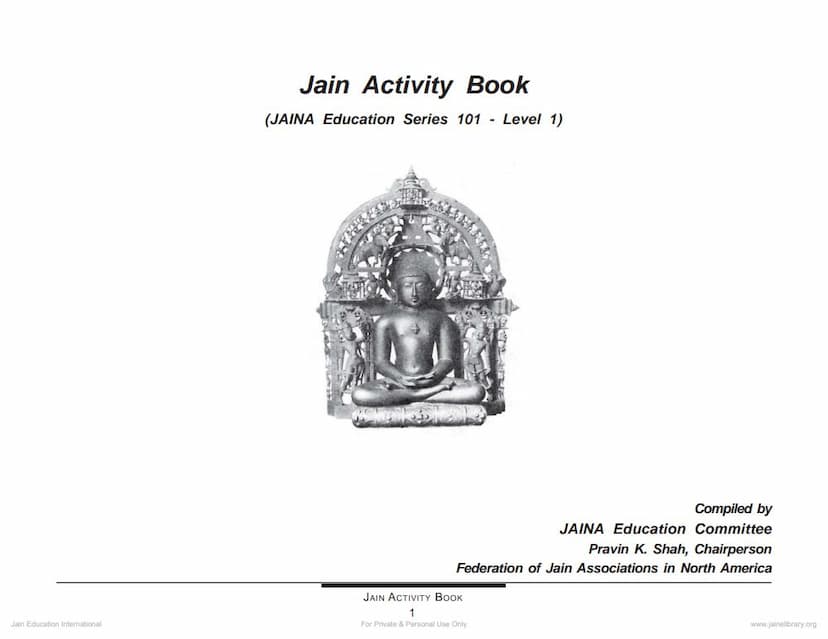JES 101 Jain Activity Book Level 1 Book
Added to library: September 1, 2025

Summary
This document is a comprehensive Jain Activity Book, Level 1, designed for young children. It's a revised third edition published by the JAINA Education Committee to promote Jain principles and awareness among English-speaking youth.
Here's a breakdown of its content:
Overall Purpose and Philosophy:
- Promoting Jainism: The book aims to instill the fundamental values of Jainism, including non-violence (Ahimsä), reverence for life, environmental protection, and compassionate interdependence.
- Accessible Education: It addresses the need for Jain educational material in English for children growing up in Western countries.
- Respectful Use: While not copyrighted, the material is to be used respectfully.
- Vegan and Alcohol/Drug-Free Lifestyle: The dedication and special thanks highlight the importance of a vegan and alcohol/drug-free lifestyle as stemming from a desire to minimize harm.
Content Overview:
-
Introduction and Acknowledgements (Pages 1-10):
- Introduces the book and its purpose.
- Lists contributors and supporters, highlighting the collaborative effort.
- Explains the JAINA Education Series structure, categorized by age levels.
- Discusses the importance of making Jain principles globally accessible through various media.
- Provides a pronunciation guide with a disclaimer about the simplified transliteration.
-
Jain Prayers (Pages 11, 19-27):
- Mangalācharan (Navakār Mantra): The core Jain prayer, with its transliteration, meaning, and significance.
- Chattāri Mangalam: A prayer recognizing the auspiciousness of the Arihantas, Siddhas, Sädhus, and the Jain Dharma.
- Darshanam Devadevasya: A verse about the auspiciousness of seeing the idol of a Tirthankar.
- Various Auspicious Verses: Includes verses praising Lord Mahavir, Lord Rushabhadev, and the five Parameṣṭhis.
- Asatyo Māhe Thi: A prayer seeking guidance from untruth to truth, darkness to light, and mortality to immortality.
- Maitri Bhavana: A prayer for universal amity, compassion, and goodwill.
-
Jain Symbols (Pages 11, 28-38):
- Jai Jinendra: Explains the greeting and its meaning of recognizing the divine within others.
- Jinālaya (Jain Temple): Describes the temple as a place of peace and introspection, where God resides within.
- Om (Aum): Explains its meaning of completeness, eternity, and its representation of the five supreme beings (Panch Parameṣṭhi).
- Hrim: Describes it as a seed mantra symbolizing the divine energy of the Tirthankars.
- Arhum: A mantra representing all sounds, symbolizing the silent sound of the universe.
- Swastika: Explains its symbolism of the four states of rebirth, the three jewels of Jainism, and the Siddhashilä.
- Universal Jain Symbol: Details the meaning of the universe outline, the raised hand (Ahimsä), the wheel of rebirth, and the motto "Parasparopagraho Jivänäm" (Living Beings Render Service to One Another).
- Federation of JAINA Logo: Highlights the JAINA symbol, featuring the Om instead of the Swastika for Western audiences.
- Ārati: Explains the ritual of waving lamps, symbolizing the dispelling of negativity and the five great vows.
- Mangal Deevo: Describes the single-wick lamp as a symbol of Kevaljnän (infinite knowledge).
-
Coloring Section (Pages 11, 39-86):
- Länchhans (Emblems or Symbols): Introduces the unique emblems associated with each of the 24 Tirthankars, their significance on idols, and differences between Digambar and Shvetämbar traditions. It lists and depicts the länchhans for all 24 Tirthankars.
- Dreams of a Tirthankar's Mother: Details the auspicious dreams (14 or 16) that a mother of a Tirthankar typically dreams, along with their interpretations. These include dreams like the elephant, bull, lion, goddess Lakshmi, garland, moon, sun, flag, vase, lotus lake, ocean, celestial plane, heap of jewels, smokeless fire, pair of fish, and lofty throne.
- Postures of Sämäyika, Pratikraman, and Pujä Rituals: Illustrates various ritualistic postures and practices, such as standing and meditation postures for Sämäyika/Pratikraman, mala (rosary) meditation, guru sthāpanā and uthāpanā, Tirthankar and Guru Vandana, and Chaitya Vandan.
- Ashta Prakäri Pujā / Ashta Dravya Pujā: Explains the eight types of offerings (water, sandalwood, flower, incense, lamp, rice, sweet, fruit) used in Jain worship, their significance, and the associated virtues. It also provides recommendations for a compassionate approach to puja materials.
-
Activity Section (Pages 11, 109-148):
- This section includes various activities designed to reinforce learning.
- Dot-to-dots and coloring pages: Features the länchhans of the Tirthankars for children to color and identify.
- Fill-in-the-blanks: Tests comprehension of Jain terms and concepts.
- Matching exercises: Connects puja materials with their meanings.
- Ordering exercises: Requires children to arrange the order of länchhans and dreams of a Tirthankar's mother.
- Multiple Choice Questions: Assesses understanding of Tirthankar details, idol characteristics, and Jain practices.
- Chart Completion: Asks children to fill in the chart of Tirthankars and their länchhans.
-
India and Jain Tirthas (Pages 11, 149-153):
- Popular Jain Tirthas in India: Highlights significant pilgrimage sites in India and includes a map for labeling. It poses questions about the Tirthankars associated with these places.
- Jain Temples Around the World: Lists Jain temples outside India and uses a map to identify their locations.
The book is structured to be engaging and educational, using a combination of descriptive text, visuals, and interactive activities to teach young Jains about their heritage and religious principles.